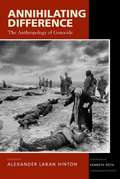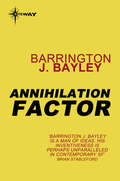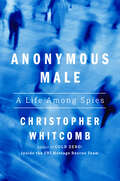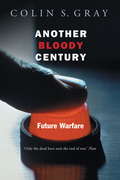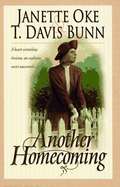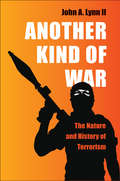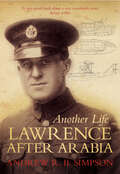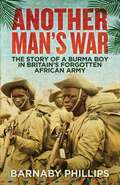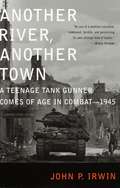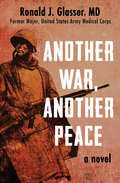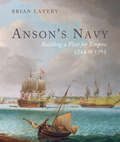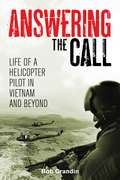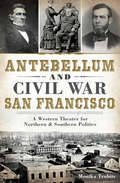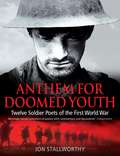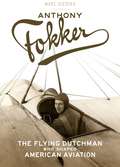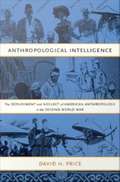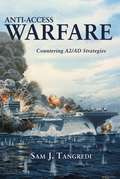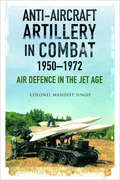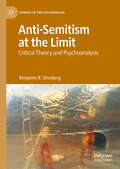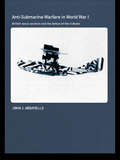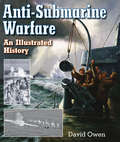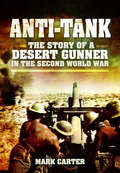- Table View
- List View
Annie, Between the States
by L. M. ElliottAnnie's home and heart are divided by the Civil War.Annie Sinclair's Virginia home is in the battle path of the Civil War. <P><P> Her brothers, Laurence and Jamie, fight to defend the South, while Annie and her mother tend to wounded soldiers. <P><P>When she develops a romantic connection with a Union Army lieutenant, Annie's view of the war broadens. <P>Then an accusation calls her loyalty into question. A nation and a heart divided force Annie to choose her own course.
Annihilating Difference: The Anthropology of Genocide
by Alexander Laban HintonThis collection of original essays on genocide explores a wide range of cases, including Nazi Germany, Cambodia, Guatemala, Rwanda, and Bosnia.
Annihilation Factor
by Barrington J. BayleyFrom the Garlowe Clusters in the north to the Veils of Darkness in the south, the Star Kingdom sprawled over roughly a fifth of the galaxy. So huge was this realm that those who tussled for power over it seemed unable to appreciate that it faced annihilation by the Patch, a roving region of peculiar pseudo-energy a light-year across which drained the life-force from any living thing it encountered.The Patch had moved into the Kingdom and was systematically feeding on system after system. Cynically unperturbed by the appalling loss of life, the royal houses merely tried to involve the Patch in their machinations, to the extent that civil war broke out all over again. But in the event, the Patch was to provide the crucial factor in the struggle for absolute power. The Annihilation Factor!
Anonymous Male: A Life Among Spies
by Christopher WhitcombA no-holds-barred memoir about identity, from a former Hostage Rescue Team sniper who left the FBI on 9/11 only to lose himself, moving deeper into a world of spies. In September 2001, Christopher Whitcomb was the most visible FBI agent in the world. His bestselling memoir, Cold Zero, had led to novels, articles in GQ, and op-eds in The New York Times. He appeared on Imus in the Morning, Larry King, and Meet the Press; he was nominated for a Peabody reporting for CNBC. He played poker with Brad Pitt while contracting for the CIA. Then one day in 2006, without warning, Whitcomb packed a bag, flew into Somalia, and dropped off the face of the earth. For fifteen years, he waged a mercenary war on himself, traveling the world with aliases, cash, and guns. He built a private army in the jungles of Timor-Leste, working contracts for intelligence agencies, where he survived a coup d&’état only to lose his friends, abandon his family, and give up on God.And though many stories might have ended there, Anonymous Male is a tale of redemption. While surfing the wilds of Indonesia, Whitcomb found himself trapped beneath a giant wave, where, at the edge of drowning, he came to terms with the chaos of his own clandestine life. He survived the wave to find his way home and rebuild the world that he had abandoned. Anonymous Male is a riveting memoir about loss and recovery, a deeply intimate story that spans continents, war, politics and the media. It is a confession, and a cautionary tale of what happens to people whom the government trains to lie, even to themselves.
Another Bloody Century: Future Warfare
by Colin S. GrayHow the wars of the near future will be fought and who will win themMany nations, peoples and special interest groups believe that violence will advance their cause. Warfare has changed greatly since the Second World War; it continued to change during the late 20th century and this process is still accelerating. Political, technological, social and religious forces are shaping the future of warfare, but most western armed forces have yet to evolve significantly from the cold war era when they trained to resist a conventional invasion by the Warsaw Pact. America is now the only superpower, but its dominance is threatened by internal and external factors. The world's most hi-tech weaponry seems helpless in the face of determined guerrilla fighters not afraid to die for their beliefs.Professor Colin Gray has advised governments on both sides of the Atlantic and in ANOTHER BLOODY CENTURY, he reveals what sort of conflicts will affect our world in the years to come.
Another Bloody Century: Future Warfare
by Colin S. GrayHow the wars of the near future will be fought and who will win themMany nations, peoples and special interest groups believe that violence will advance their cause. Warfare has changed greatly since the Second World War; it continued to change during the late 20th century and this process is still accelerating. Political, technological, social and religious forces are shaping the future of warfare, but most western armed forces have yet to evolve significantly from the cold war era when they trained to resist a conventional invasion by the Warsaw Pact. America is now the only superpower, but its dominance is threatened by internal and external factors. The world's most hi-tech weaponry seems helpless in the face of determined guerrilla fighters not afraid to die for their beliefs.Professor Colin Gray has advised governments on both sides of the Atlantic and in ANOTHER BLOODY CENTURY, he reveals what sort of conflicts will affect our world in the years to come.
Another Homecoming
by Janette Oke Davis BunnDuring World War II Martha faces difficult decisions when her husband is reported missing in action. THE WORLD IS AT WAR. A young man bravely kisses his weeping bride goodbye at the train station, leaving her all alone. Then the dreaded telegram, and a decision that nearly tears her apart... A LITTLE GIRL GROWS into young womanhood, unaware of the forces that swirl around her past and her future. WILL THERE BE... Another Homecoming
Another Kind of War: The Nature and History of Terrorism
by John A. LynnAn accessible and comprehensive history of terrorism from ancient times to the present In the years since 9/11, there has been a massive surge in interest surrounding the study of terrorism. This volume applies distinguished military historian John Lynn’s lifetime of research and teaching experience to this difficult topic. As a form of violence that implies the threat of future violence, terrorism breeds insecurity, vulnerability, and a desire for retribution that has far-reaching consequences. Lynn distinguishes between the paralyzing effect of fear and the potentially dangerous and chaotic effects of moral outrage and righteous retaliation guiding counterterrorism efforts. In this accessible and comprehensive text, Lynn traces the evolution of terrorism over time, exposing its constants and contrasts. In doing so, he contextualizes this violence and argues that a knowledge of the history and nature of terrorism can temper its psychological effects, and can help us more accurately and carefully assess threats as well as develop informed and measured responses.
Another Life: Lawrence After Arabia
by Andrew R B SimpsonT.E. Lawrence found global recognition for his leadership of the Arab Revolt during World War I, preparing the ground for the final Allied offensive in 1918. He was hailed as a hero, but little is known about this mysterious and charismatic man after those events. Here is Lawrence’s life after Arabia, his service in the RAF and the Tank Corps as a mere ranker, and how he became an expert in the technology of the new RAF. The book examines the work he did for the 1929 Schneider Trophy Race, the development of the new RAF 200 seaplane tender, and the development of its armour plated offspring, the Armoured Target Boat. It also investigates his literary endeavours and his tragically early death, a sad end to a Renaissance man of all talents, an academic, a talented engineer and a soldier sans pareil. T.E. was offered exalted diplomatic positions by Churchill, implored by Nancy Astor to re-enter the fray as the Nazi threat grew, socialised with the Cliveden set, argued with the Archbishop of Canterbury. He made lasting friendships with humble squaddies. His self-loathing was expressed physically. Consulting primary sources and also having interviewed some of those who knew Lawrence after Arabia the author portrays the last years of one of the most astonishing figures of the 20th century.
Another Man's War: The Story Of A Burma Boy In Britain's Forgotten Army
by Barnaby PhillipsIn December 1941 the Japanese invaded Burma. For the British, the longest land campaign of the Second World War had begun. 100,000 African soldiers were taken from Britain’s colonies to fight the Japanese in the Burmese jungles. They performed heroically in one of the most brutal theatres of war, yet their contribution has been largely ignored. Isaac Fadoyebo was one of those 'Burma Boys’. At the age of sixteen he ran away from his Nigerian village to join the British Army. Sent to Burma, he was attacked and left for dead in the jungle by the Japanese. Sheltered by courageous local rice farmers, Isaac spent nine months in hiding before his eventual rescue. He returned to Nigeria a hero, but his story was soon forgotten. Barnaby Phillips travelled to Nigeria and Burma in search of Isaac, the family who saved his life, and the legacy of an Empire. Another Man’s War is Isaac’s story.
Another River, Another Town: A Teenage Tank Gunner Comes of Age in Combat--1945
by John P. IrwinMany narrative accounts of men in combat during World War II have conveyed the horrors and emotions of warfare. However, not many reveal in such an intimate way the struggle of innocent youth to adapt to the primitive code of "kill or be killed," to transform from lads into combat soldiers. Another River, Another Town is the story of John P. Irwin, a teenage tank gunner whose idealistic desire to achieve heroism is shattered by the incredibly different view of life the world of combat demands. He comes to the realization that the realm of warfare has almost nothing in common with the civilian life from which he has come. The interminable fighting, dirt, fatigue, and hunger make the war seem endless. In addition to the killing and destruction on the battlefield, Irwin and his crew are caught up in the unbelievable depravity they encounter at Nordhausen Camp, where slave laborers are compelled to work themselves to death manufacturing the infamous V-rockets that have been causing so much destruction in London, and that are expected one day to devastate Washington, D.C. At the end of the war, the sense of victory is, for these men, overshadowed by the intense joy and relief they experience in knowing that the fighting is at last over.From the Hardcover edition.
Another War, Another Peace: A Novel
by Ronald J. GlasserThe powerful story of an unlikely friendship and a doctor&’s re-education on the battlefields of the Vietnam WarFresh out of medical school and planning to enter academia, David pragmatically applies to serve in the US Army, thinking he would rather work in a stateside military hospital than get drafted. But when he gets reassigned to Southeast Asia, he suddenly finds himself on a base in Vietnam. He joins a civilian aid mission on a supposedly secure plateau, and spends his days dispensing pills to villagers. As David comes to terms with the unexpected factors that brought him to Vietnam, he must adjust to many more twists and turns—among them his relationship with his driver, Tom, a young, rough-hewn Southerner whose reticence feels unnervingly like indifference. Gradually, however, David sees that there&’s far more to Tom than he initially thought. As their friendship grows, David also realizes that his fellow doctors and the troops on base hold widely diverging opinions about the war and its objectives. As it becomes clear that their base is located on a key strategic route—the notorious Ho Chi Minh Trail—and thus a vulnerable target, it&’s only a matter of time before battles break out . . .
Anson's Navy: Building a Fleet for Empire 1744–1763
by Brian LaveryDespite a supreme belief in itself, the Royal Navy of the early eighteenth century was becoming over-confident and outdated, and it had more than its share of disasters and miscarriages including the devastating sickness in Admiral Hosier’s fleet in 1727; failure at Cartagena, and an embarrassing action off Toulon in 1744\. Anson’s great circumnavigation, though presented as a triumph, was achieved at huge cost in ships and lives. And in 1756 Admiral Byng was shot after failure off Minorca. In this new book, the bestselling author Brian Lavery shows how, through reforms and the determined focus of a number of personalities, that navy was transformed in the middle years of the eighteenth century. The tide had already begun to turn with victories off Cape Finisterre in 1747, and in 1759 the navy played a vital part in the ‘year of victories’ with triumphs at Lagos and Quiberon Bay; and it conducted amphibious operations as far afield as Cuba and the Philippines, and took Quebec. The author explains how it was fundamentally transformed from the amateurish, corrupt and complacent force of the previous decades. He describes how it acquired uniforms and a definite rank structure for officers; and developed new ship types such as the 74 and the frigate. It instigated a more efficient (if equally brutal) method of recruiting seamen, and boosted morale and motivation and a far more aggressive style of fighting. The coppering of ships’ hulls and the solving of the problems associated with longitude and scurvy, were also hugely significant steps. Much of this transformation was due to the forceful if enigmatic personality of George, Lord Anson. In a largely static society, he changed the navy so that it was fit for purpose, and in readiness for Nelson just decades later. Using a mass of archival evidence and a mix of official reports and personal reminiscences, this book offers a fascinating and engrossing analysis of all these far-reaching reforms, which in turn led to the radical transformation of Britain’s navy into a truly global force. The consequential effect on the world’s history would be huge.
Answering the Call: Life of a Helicopter Pilot in Vietnam
by Bob GrandinIn 1966, Bob Grandin was a Royal Australian Airforce helicopter pilot stationed in Vietnam. This book is written from the logbook he kept while working in Nui Dat and is a fascinating look at life during war – the dangers, the challenges and the mundaneness. On 18 August he was co-pilot on a 9 Squadron Iroquois &‘Huey&’ helicopter that flew over the enemy to resupply desperate solders engaged in battle at the Long Tan rubber plantation. Enduring extremely poor weather conditions and enemy fire the critical role played by Bob and 9 Squadron in the Battle of Long Tan contributed to the success of this battle. The narrative of his war experiences are interwoven with stories of his life after Vietnam, revealing the difficulties he faced back home, the impact of the war on his psyche and relationships, and his struggles with PTSD. A collection of Australian newspaper articles saved by Bob&’s father feature throughout, giving further insight into how important helicopters were in Vietnam, and also how the press reported the war to the Australian public. Answering the Call provides the unique perspective of a wartime helicopter pilot and is an important addition to Vietnam War history.
Antebellum and Civil War San Francisco: A Western Theater for Northern & Southern Politics (Civil War Ser.)
by Monika TrobitsWhen Americans migrated westward, they took their politics with them, making San Francisco a microcosm of the nation as the Civil War loomed. Spurred by the promise of gold, hungry adventurers flocked to San Francisco in search of opportunity on the eve of the Civil War. The city flourished and became a magnet for theater. Some of the first buildings constructed in San Francisco were theater houses, and John Wilkes Booth&’s famous acting family often graced the city&’s stages. In just two years, San Francisco&’s population skyrocketed from eight hundred to thirty thousand, making it an &“instant city&” where tensions between transplanted Northerners and Southerners built as war threatened the nation. Though seemingly isolated, San Franciscans took their part in the conflict. Some extended the Underground Railroad to their city, while others joined the Confederate-aiding Knights of the Golden Circle. Including a directory of local historic sites and streets, author Monika Trobits chronicles the dramatic and volatile antebellum and Civil War history of the City by the Bay. Includes photos
Anthem for Doomed Youth: Twelve Soldier Poets of the First World War
by Prof Jon StallworthyLeading poet and former professor of English Literature, Jon Stallworthy, tells the story of the lives and work of twelve major poets of the First World War and provides selections of their best work. The First World War began with flag-waving, parades and poets inspired by abstract ideals. In part this reflected the national mood , but it revealed an almost universal failure to understand what modern mass warfare would really mean. The story of the 'war poets' is also the story of an awakening to the full horror of what the twentieth century came to know as 'The Great War'.Wilfred Owen said, 'My subject is War - and the pity of War'. He also said 'true Poets must be truthful'. The best war poetry was the work of writers who were also serving soldiers and was born out of their desire to tell the truth about what it was to be a soldier in the trenches - what it felt like, what it did to you and what it did to your fellow soldiers, friend or foe. The greatness of the poetry lay not just in the writer's talent, but in the unflinching accuracy with which it portrayed their terrible circumstances.
Anthony Fokker: The Flying Dutchman Who Shaped American Aviation
by Marc DierikxComprehensive biography of Anthony Fokker, the famed Dutch pilot and daredevil aviatorAnthony Fokker: The Flying Dutchman Who Shaped American Aviation tells the larger-than-life true story of maverick pilot and aircraft manufacturer Anthony Fokker. Fokker came from an affluent Dutch family and developed a gift for tinkering with mechanics. Despite not receiving a traditional education, he stumbled his way into aviation as a young stunt pilot in Germany in 1910. He survived a series of spectacular airplane crashes and rose to fame within a few years. A combination of industrial espionage, luck, and deception then propelled him to become Germany's leading aircraft manufacturer during World War I, making him a multimillionaire by his midtwenties.When the German Revolution swept the country in 1918 and 1919, Fokker made a spectacular escape to the United States. He set up business in New York and New Jersey in 1921, and shortly thereafter became the world's largest aircraft manufacturer. The U.S. Army and Navy acquired his machines, and his factories equipped legendary carriers such as Pan American and TWA at the dawn of commercial air transport.Yet despite his astounding success, his empire collapsed in the late 1920s after a series of ill-conceived business decisions and deeply upsetting personal dramas. In 1927, aviator Richard Byrd solicited a Fokker three-engine plane to be the first to fly non-stop across the Atlantic. The plane was damaged on a test flight and Charles Lindbergh beat him to it. Lindbergh's solo adventure in the Spirit of St. Louis earned him--and cost Fokker--a lasting place in the history books. Using previously undiscovered records and primary sources, Marc Dierikx traces Fokker's extraordinary life and celebrates his spectacular achievements.
Anthropological Intelligence: The Deployment and Neglect of American Anthropology in the Second World War
by David H. PriceBy the time the United States officially entered World War II, more than half of American anthropologists were using their professional knowledge and skills to advance the war effort. The range of their war-related work was extraordinary. They helped gather military intelligence, pinpointed possible social weaknesses in enemy nations, and contributed to the army's regional Pocket Guide booklets. They worked for dozens of government agencies, including the Office of Strategic Services (OSS) and the Office of War Information. At a moment when social scientists are once again being asked to assist in military and intelligence work, David H. Price examines anthropologists' little-known contributions to the Second World War. Anthropological Intelligence is based on interviews with anthropologists as well as extensive archival research involving many Freedom of Information Act requests. Price looks at the role played by the two primary U. S. anthropological organizations, the American Anthropological Association and the Society for Applied Anthropology (which was formed in 1941), in facilitating the application of anthropological methods to the problems of war. He chronicles specific projects undertaken on behalf of government agencies, including an analysis of the social effects of postwar migration, the design and implementation of OSS counterinsurgency campaigns, and the study of Japanese social structures to help tailor American propaganda efforts. Price discusses anthropologists' work in internment camps, their collection of intelligence in Central and South America for the FBI's Special Intelligence Service, and their help forming foreign language programs to assist soldiers and intelligence agents. Evaluating the ethical implications of anthropological contributions to World War II, Price suggests that by the time the Cold War began, the profession had set a dangerous precedent regarding what it would be willing to do on behalf of the U. S. government.
Anti-Access Warfare
by Sam TangrediThe book is the definitive conceptual and historical introduction to the concept of anti-access strategies. Unlike current studies, it is not simply technology focused. Nor is it primarily intended as critique of the current Air-Sea Battle concept. It combines conceptual thinking with historical examples and potential scenarios in order to identify options for future defense planning.Strategies of "anti-access," also known as "area denial" (more recently combined into the awkward acronym "A2/AD") are presumed to be the primary threats to the employment of U.S. military forces in overseas crises. This presumption has gradually evolved into a joint concept of "operational access." Anti-access capabilities appear to be the current military posture of the People's Republic of China and Islamic Republic of Iran. The study of anti-access or area denial strategies for use against American power projection capabilities has strong naval roots-which have been largely ignored by the most influential commentators. In reality, denial of access was the Soviet Navy's operational objective during the Cold War. The first use of the actual anti-access term can be traced to a series of "anti-Navy" studies by the Office of Net Assessment designed to examine the ability of the U.S. Navy to carry out its Maritime Strategy and, later, "...From the Sea" strategic vision. Sustained long-range power projection is both a unique strength of U.S. military forces and a requirement for an activist foreign policy and forward defense. In more recent years, the logic of the anti-access approach has been identified by the Department of Defense as a threat to this U.S. capability and the joint force; countering it is one of the defense priorities identified in the President's directions issued this past January. In addition to potential regional powers, a number of think-tanks have suggested that non-state actors, such as terrorist organizations, are developing anti-access/area denial capabilities.The book's conclusions differ from most commentary on anti-access. Rather than a technology-driven post-Cold War phenomenon, the anti-access approach has been a routine element of grand strategy used by strategically weaker powers to confront stronger powers throughout history. But they have been largely unsuccessful when confronting a stronger maritime power. Although high technology weapons capabilities enhance the threat, they also can be used to mitigate the threat. Rather than arguing against reliance on maritime forces-presumably because they are no longer survivable-the historical analysis argues that maritime capabilities are key in "breaking the great walls."
Anti-Aircraft Artillery in Combat, 1950–1972: Air Defence in the Jet Age
by Colonel Mandeep SinghAn in-depth look at the combat performance of ground-based air defenses during the Korean War, Vietnam War, Middle East conflicts, and other campaigns. Though anti-aircraft artillery was extensively used in combat in the First World War, it wasn&’t until World War II that it came into prominence, shooting down more aircraft than any other weapon and seriously degrading the conduct of air operations. In the battle between the attackers and anti-aircraft artillery, the latter had the upper hand when the war ended. The post-war years saw a decline in anti-aircraft artillery as peace prevailed, and the advent of the jet aircraft seemed to tilt the balance in favor of the aircraft as they flew faster and higher, seemingly beyond the reach of anti-aircraft artillery. It would take all the hi-tech equipment and the guile and cunning that anti-aircraft artillery could muster to try and reclaim pole position. It is that story, of the tug of war between the aircraft and artillery, that forms the narrative of this book—as it traces the history of combat employment of anti-aircraft artillery from the Korean War, in effect the first Jet Age war, to the War of Attrition between Arab states and Israel when the missiles came of age, sending the aircraft scurrying for cover. Mandeep Singh&’s book is the first attempt to look at the performance of anti-aircraft artillery, incorporating the views, analyses and experiences of Soviet, Arab and South Asian Armies through the major wars between 1950 and 1972.
Anti-Semitism at the Limit: Critical Theory and Psychoanalysis (Studies in the Psychosocial)
by Benjamin B. StrosbergIn this book, Benjamin Strosberg explores difficulties and anxieties inherent in studying, defining, and defending against anti-Semitism by tracing a concurrent difficulty in thinking about Jewishness, which has historically served as a limit case for central social categories such as outsider, religion, race, gender, and nation. Dr. Strosberg draws on Zygmunt Bauman’s concept of proteophobia—the anxious fear of what doesn’t fit into clear-cut categories—to think more carefully about anti-Semitism as response to the complex-realities of ambivalence and otherness. The book proposes ‘negative psychology’ as a methodology for studying anti-Semitism and proteophobia rooted in psychoanalysis and Theodor Adorno’s Critical Theory. Drawing from lived experiences, contemporary events, and debates in the field, this compelling work explores the broad implications of the investigation of anti-Semitism for politics, education, and psychoanalysis, as well as the specific implications for Jewish identity and resistance.
Anti-Social Media: Conventional Militaries in the Digital Battlespace
by Kevin FosterOver the past decade the gravitational centre of contemporary conflict has shifted from the physical battlefield to the online battlespace, where the ingenuity of non-state actors has vexed governments and tested their militaries. Devising new architectures of participation, Al Qaeda and ISIS have weaponised social media and empowered their dispersed followers to organise, communicate and dominate the information domain. Kevin Foster shows how conventional militaries in the US, Britain, Israel and Australia have responded to this challenge by integrating social media into their systems and operations, and the organisational and cultural impediments they have confronted. Foster traces each military's social media journey, appraising the strategies, doctrine and policies developed to regulate its management and use. From the ADFA Skype sex scandal to the IDF's sophisticated integration of the real and virtual spaces of war, Anti-Social Media examines the good, the bad and the indifferent in the armed forces' halting advance towards social media competence.
Anti-Submarine Warfare in World War I: British Naval Aviation and the Defeat of the U-Boats (Cass Series: Naval Policy and History)
by John AbbatielloInvestigating the employment of British aircraft against German submarines during the final years of the First World War, this new book places anti-submarine campaigns from the air in the wider history of the First World War. The Royal Naval Air Service invested heavily in aircraft of all types—aeroplanes, seaplanes, airships, and kite balloons—in order to counter the German U-boats. Under the Royal Air Force, the air campaign against U-boats continued uninterrupted. Aircraft bombed German U-boat bases in Flanders, conducted area and ‘hunting’ patrols around the coasts of Britain, and escorted merchant convoys to safety. Despite the fact that aircraft acting alone destroyed only one U-boat during the war, the overall contribution of naval aviation to foiling U-boat attacks was significant. Only five merchant vessels succumbed to submarine attack when convoyed by a combined air and surface escort during World War I. This book examines aircraft and weapons technology, aircrew training, and the aircraft production issues that shaped this campaign. Then, a close examination of anti-submarine operations—bombing, patrols, and escort—yields a significantly different judgment from existing interpretations of these operations. This study is the first to take an objective look at the writing and publication of the naval and air official histories as they told the story of naval aviation during the Great War. The author also examines the German view of aircraft effectiveness, through German actions, prisoner interrogations, official histories, and memoirs, to provide a comparative judgment. The conclusion closes with a brief narrative of post-war air anti-submarine developments and a summary of findings. Overall, the author concludes that despite the challenges of organization, training, and production the employment of aircraft against U-boats was largely successful during the Great War. This book will be of interest to historians of naval and air power history, as well as students of World War I and military history in general.
Anti-Submarine Warfare: An Illustrated History
by David OwenA deep dive into the tactics and technology used to defend against submarines—from the opening of the First World War through World War II and beyond. The submarine was undoubtedly the most potent purely naval weapon of the twentieth century. In two world wars, enemy underwater campaigns were very nearly successful in thwarting Allied hopes of victory—indeed, annihilation of Japanese shipping by US Navy submarines is an indicator of what might have been. That the submarine was usually defeated is a hugely important story in naval history, yet this is the first book to treat the subject as a whole in a readable and accessible manner. It concerns individual heroism and devotion to duty, but also ingenuity, technical advances and originality of tactical thought. What developed was an endless battle between forces above and below the surface, where a successful innovation by one side eventually produces a countermeasure by the other in a lethal struggle for supremacy. Development was not a straight line: wrong ideas and assumptions led to defeat and disaster. &“Iconography (with dozens of photographs and often large-format diagrams), a vast bibliography and a complete and documented general approach make this volume a work of great quality and of great interest for all enthusiasts and scholars of this very interesting subject.&”—Storia Militare &“The modeller will not only find the text engaging but there is a superb collection of photographs and illustrations which of course include submarines, corvettes and destroyers. Subjects which the modeller increasingly appreciates. Highly recommended.&”—Model Boats
Anti-Tank: The Story of a Desert Gunner in the Second World War
by Mark CarterA combat memoir by a British Royal Artillery soldier recounting the fight against Rommel&’s panzers, conveyed with wit and vivid detail. This is a vivid and perceptive insight into the horrors of war as experienced by British soldiers of the Royal Artillery in the Desert War in 1941 and 1942. The author, who fought in the campaign, brings to life the true nature of the fighting as British gunners struggled to defend their comrades from the armored power of the Axis forces under Erwin Rommel. Here, too, are some of the lighter sides of war and the friendships that were made in those days of adversity. Anti-Tank takes us from the fighting of 1941 and the to-and-fro of the Benghazi Stakes through to the final Battle of El Alamein in October/November 1942—and the beginning of Eighth Army&’s advance to victory.

